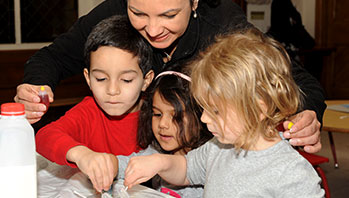- chart paper
- crayons/markers
- plastic plates
- toothpicks
- watermelon slices (with seeds)
- estimate
- seed
MA Standards:
Language/L.PK.MA.6: Use words and phrases acquired through conversations, listening to books read aloud, activities, and play.
Mathematics/Measurement and Data/PK.MD.MA.1: Recognize the attributes of length, area, weight, and capacity of everyday objects using appropriate vocabulary (e.g., long, short, tall heavy, lights, big, small, wide, narrow).
English Language Arts/Language/L.PK.MA.1.g: Use vocabulary in the Massachusetts Curriculum Framework for Mathematics pre-kindergarten standards to express concepts related to length, area, weight, capacity, and volume.
MA Draft STE Standards:
Life Sciences/From Molecules to Organisms: Inheritance and Variation of Traits/LS1/3.A: Describe/draw and compare the body parts of animals (including themselves) and plants they are investigating [System] and explain functions of some of the observable body parts. [Structure and Function]
Life Sciences/From Molecules to Organisms: Inheritance and Variation of Traits/LS1/3.C: Use their sense in their exploration and play to gather information. [Structure and Function]
Head Start Outcomes:
Logic and Reasoning/Reasoning and Problem Solving: Classifies, compares, and contrasts objects, events, and experiences.
PreK Learning Guidelines:
English Language Arts/Language 2: Participate actively in discussions, listen to the ideas of others, and ask and answer relevant questions.
Mathematics/Measurement 13: Use estimation in meaningful ways and follow up by verifying the accuracy of estimations.
Small Group: Estimate Watermelon Seeds

© Commonwealth of Massachusetts, Department of Early Education and Care (Jennifer Waddell photographer). All rights reserved.
STEM Key Concepts: Many foods that animals, including humans, eat come from plants; We eat certain leaves, roots, fruits, and seeds; Fruits have seeds; Seeds hold what a plant needs to make more of itself
ELA Focus Skills: Listening and Speaking, Follow Directions, Predicting, Vocabulary
Educator Prep: Prepare a large sheet of chart paper with children’s names in a column down the left-hand side. Title the chart “My Seed Estimate.”
Safety Tips:
- Remind children to wash their hands before and after the activity.
- Take children’s dietary needs into account before introducing them to any food items.
Give each child a paper plate with a slice of watermelon on it. Tell children they are going to make an estimate, or a good guess, as to how many seeds they think are in their slice of watermelon.
- First have children use a toothpick to take all the seeds out of the watermelon. Say, Place all the seeds on the clean paper plate next to your watermelon slice. Tell children they can eat the watermelon as they take the seeds out.
- Then have children look at the seeds and make an estimate. Say, Look at your seeds. When I call your name, I want you to estimate, or make a good guess, how many seeds are on your plate. Have children write or dictate their estimate on the chart and then have the group count how many the child has. Compare the actual number to the estimate.
- Then move on to the next child and repeat the process. Be sure all children partake until the last child has estimated and counted his or her seeds.
Hang the estimation chart in the Science and Math Center for children to revisit.
